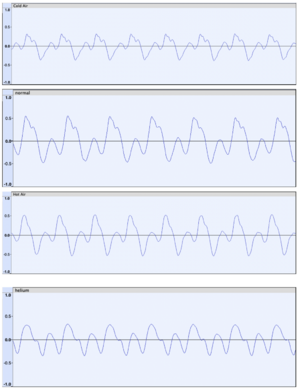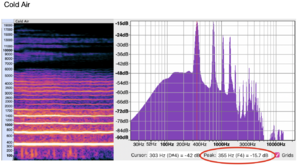PHYS341/2023/Project12
Can We Modify the Timbre of Our Voice Without Modifying Our Anatomy?
The short answer is yes. But to explain why, you will need to know a few things such as…
- What about our anatomy allows us to produce sound
- How we produce sound & why each person has a unique timbre
- The relationship between the speed of sound waves, frequency, and wavelength
What About Our Anatomy Allows Us to Produce Sound

Our voice is a very unique instrument. The way we are able to produce sound is through our trachea, larynx, and vocal folds.
The trachea: is a tube of cartilage that allows air to travel to and from the lungs, it is also called the windpipe.
The larynx: is the area of the throat used for breathing, swallowing, talking, etc. It contains the vocal folds and sits above the trachea. The larynx, also called the voice box, is made of 3 main cartilages, 1 bone, and 5 muscle groups. 2 of its cartilages, the arytenoid cartilages, help move the vocal folds and produce unique sounds.
The vocal folds: are muscle and cartilage that protect the airway of the larynx and make sure nothing unwanted goes down the trachea and into the lungs. The vocal folds, or vocal cords, also shift in tension and length through stretching and relaxing to allow us to produce different frequencies.[1]
How We Produce Sound & Why Each Person Has A Unique Timbre

The vocal folds produce sound by interrupting air escaping the lungs. The number of times air is interrupted per second, the frequency, determines pitch of the sound we produce.[2] We can understand this more clearly with the Bernoulli effect which states the pressure of air decreases, the velocity increases. If the velocity of air moving between two objects increases, the two objects will suction together as the pressure between becomes lower than the surrounding pressure.
We increase velocity as we push air from our lungs and through our vocal folds, this then decreases the pressure of air between the folds and creates a suction effect. The suction is what brings the folds together and allows them to vibrate and oscillate![3] These oscillations produce sound waves that are amplified by our natural voice tract resonators - our throat, mouth cavity, and nasal passages.[4]
The resonators are what provide each person's sound or timbre.[5] Timbre is the unique colour, quality, or tone of a person's voice.[6] Some of the many frequencies we produce when we speak or sing resonate more clearly within our vocal tract resonators than others. The shape we transform our mouths into and the placement of our air in our vocal tract as we sing also helps different frequencies resonate in different areas allowing us to create different timbres.[7]
We can achieve different pitch/frequency through stretching and relaxing our vocal folds. If our vocal folds are stretched long and thin, the tension will increase producing a higher frequency and therefore higher pitch. If our vocal folds are relaxed to be short and thickened, the tension will decrease producing a lower frequency and therefore lower pitch. This can also have a heavier or louder sound.[1]
The Relationship Between the Speed of Sound Waves, Frequency, and Wavelength
Given the medium a wave is travelling through, the speed of sound will vary. We can see this by comparing the speed of a sound wave through air and water. Through air, the speed of sound is around 340 meters per second. Through water, sound travels much faster at a rate of 1500 meters per second.[8]
Frequency, despite a change in speed of sound, will stay the same. This can be better understood using the equation: v = f λ[9]
The speed of sound (v) is usually constant and is determined by the medium the sound wave is travelling through. Frequency (f) is determined by the force applied to the oscillating object, if that energy remains consistent, the frequency will remain constant. (In terms of our voice, the force could be air from our lungs giving energy to our vocal folds to vibrate). The wave speed (v) and frequency (f) are not influenced by each other, so the wavelength (λ) must change if the wave speed changes.[7]
In hot air, molecules are moving rapidly and density thins allowing the speed of a sound wave to travel faster, therefore the wavelength will lengthen. In cold air, molecules are moving slowly and density thickens causing the speed of a sound wave to decrease, therefore the wavelength will shorten. As a wavelength either stretches out or condenses, its ability to resonate in the vocal tract changes.[9]
This is demonstrated when we inhale helium. Helium is very light and sound waves can move very fast within it, therefore the wavelength of the sound waves lengthen. The wavelengths of lower frequencies become so long they fail to resonate well in our vocal tract. The wavelengths of higher frequencies are also becoming longer, but to a point where they naturally resonate much better in the vocal tract producing a sound that seems lighter or higher than it actually is.[7]
Our lungs cannot withstand the inhalation of extreme temperatures, but if we were to breathe in extremely hot or cold air, we would be altering the medium and therefore see similar effects to that of helium.
Experiment:
To demonstrate how timbre changes given the medium, and not the modification of the anatomy, the note F4 (349.23 Hz)[10] was sung on “La” with varying mediums of room temperature (normal) air, cold air, hot air, and helium. To use hot air as a medium, steam was inhaled through a straw. To use cold air as a medium, air from within a cup of ice was inhaled through a straw. If the wave shape on the time graph changes, we will know the timbre has changed as timbre is represented through the wave form.[11]
Variables:
Vocal Cords & Flexibility - Just like sprinters need to warm up before a race, singers need to perform vocal exercises and warm up their vocal folds to produce a wide range of frequencies. While breathing in cold air, our vocal folds may cool and tighten. This could impact pitch and timbre as the vocal folds are unable to move as easily or smoothly[12] - for cold air, the graph demonstrating a change of timbre may be showing the strain of vocal folds under cool conditions rather than the influence of a cooler medium.
Body Temperature - When breathing in cold air, our lungs naturally warm the air to body temperature.[13] In this experiment, though cool air was breathed in, warm air may have been released through the vocal folds tainting the results.
Resources - The microphone used for the experiment was a built-in laptop microphone that may have provided lower quality sound that would impact the credibility of this analysis.
Results and Graphs:

Time Graph - Timbre:
From cold to warm air, the graphs smooths out significantly. This change in its shape represents the change in timbre. While playing back the recordings for each medium, this change in timbre was not evident to the bare ear, yet there is a clear difference shown in the graphs. With helium, we can observe that the graph takes on an entirely different shape, this change of timbre was much more obvious to the bare ear.
The medium clearly has affected timbre, but as shown in the next set of graphs, not the frequency.




Spectrogram & Spectrum Graph - Frequencies:
These graphs show that the pitch sung was consistently F4 (349.23 Hz)[10] for each medium, or within 6Hz of F4.
They also allow us to see what harmonics are most present. As cooler to warmer mediums are being used, higher harmonics become more present (between 4000Hz - 6000Hz). This may be a result of wavelengths for higher harmonics lengthening and resonating more clearly in our vocal tract.
Conclusion
By altering or changing the medium we produce sound with, we can modify the timbre of our voice without changing our anatomy. To modify the medium, we can simply heat or cool the air we breathe in. Though the timbre will not be altered enough to be heard by a plain ear, its change is reflected in the wave shape.
The timbre changes because of the relationship between the wave speed and wavelength. As a new medium alters the wave speed, the wavelength also changes. This causes different harmonics to resonate more clearly in our vocal tract, influencing our natural timbre. However, changing the medium can also impact the vocal folds, their flexibility, and how they are able to vibrate, specifically with the cold medium, which in turn can impact not only timbre, but as well the frequencies we are able to produce.
References
- ↑ 1.0 1.1 "Inside the Larynx". VoiceScienceWorks. Retrieved April 9th, 2023. Check date values in:
|access-date=(help) - ↑ "How We Make Sound". VoiceScienceWorks. Retrieved April 9th, 2023. Check date values in:
|access-date=(help) - ↑ "Vocal Production". Vocals On Stage Academy. Retrieved April 10th, 2023. Check date values in:
|access-date=(help) - ↑ "Advancing Understanding of the Voice Through Interdisciplinary Research & Education". THE VOICE FOUNDATION. February 7th, 2019. Retrieved April 9th, 2023. Check date values in:
|access-date=, |date=(help) - ↑ "Keep Your Voice Sound - How to Prevent and Avoid Voice Problems". New In Health (NIH). April 2017. Retrieved April 10th, 2023. Check date values in:
|access-date=(help) - ↑ Yona, Marie (August 11th, 2022). "What Is Vocal Timbre When It Comes To Music?". Yona Marie Music. Retrieved April 10th, 2023. Check date values in:
|access-date=, |date=(help) - ↑ 7.0 7.1 7.2 Beeler, Carolyn (November 2nd, 2015). "The exactly does helium make your voice sound so weird?". PBS WHY. Retrieved April 10th, 2023. Check date values in:
|access-date=, |date=(help) - ↑ "Sound in the Sea: Understanding Ocean Acoustics". NOAA Ocean Explorer Podcast RSS. Retrieved April 9th, 2023. Check date values in:
|access-date=(help) - ↑ 9.0 9.1 "Physics Tutorial: The Speed of Sound". the Physics Classroom. Retrieved April 10th, 2023. Check date values in:
|access-date=(help) - ↑ 10.0 10.1 "Frequencies of Musical Notes". pages.mtu.edu. Retrieved April 10th, 2023. Check date values in:
|access-date=(help) - ↑ The Editors of Encyclopaedia Britannica (March 30th, 2023). "Timbre | sound". Britannica. Retrieved April 9th, 2023. Check date values in:
|access-date=, |date=(help) - ↑ Bryne, Andrew (July 23rd, 2020). "6 Ways to Keep Your Voice Healthy During Cold Season". Backstage. Retrieved April 9th, 2023. Check date values in:
|access-date=, |date=(help) - ↑ Berklee Online. "Berklee Online Take Note - 7 Tips to Keep Your Singing Voice Healthy in Cold Weather". Berklee College of Music. Retrieved April 10th, 2023. Check date values in:
|access-date=(help)